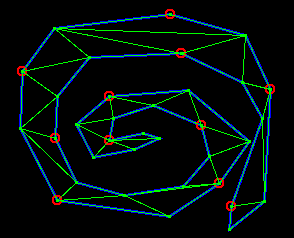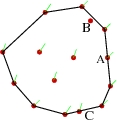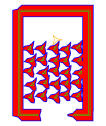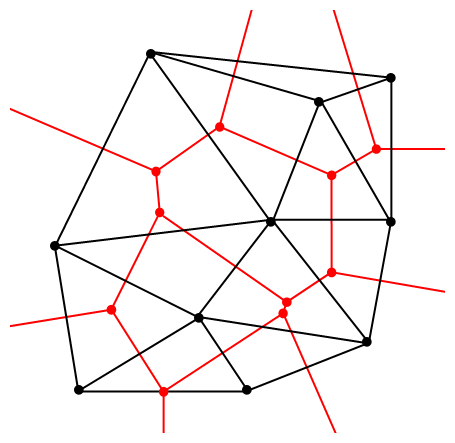Schedule
|
0.Intro
week 1 (17/2) |

What is Computational geometry? Connections with theoretical computer science, graphics, structural bioinformatics (molecular docking on the right). Computational model: real RAM. |
|
I.Convexity
2d convex hull week 1-2 (18, 25/2, 3/3) |

Convex hull in 2d (CH2). Lower bound via Sorting. Gift-wrapping algorithm (Jarvis, see right-hand side figure). Orientation Predicate, or CCW (counter-clockwise) for 3 points. Incremental algorithm (Βeneath-beyond) and upper bound. Extreme points. Theory Assignment 1. Solution. Demos from older programming assignments: Wrap2D, Marriage-before-Conquest, 3d CH. Demos 2010: Μ.Ζερβός, Δανελάκης-Σαϊτη. |
|
3d convex hull
week 3-4 (4, 10/3) |

Extension to CH3 (fullerene C_60 molecule on the right). General dimension, polytopes, facets, faces. Types of polytopes: simplex/simple/simplicial polytopes, normal cones. Theory Assignment 2. Solution. Incremental algorithm, worst-case complexity, general dimension. McMullen's upper bound theorem.Lower/upper hull, projection, regular/nonregular triangulations, Secondary graph/polytopes, Gelfand-Kapranov-Zelevinsky theorem. Flips (including degenerate cases). See Book "Triangulations" by DeLoera, Rambau, Santos (pp.5-36,41-57-72). |
|
CGAL-Python, Visibility, nonconvex polygons
week 5 (17-18/3) |

Intro to Python (slides). Connection with CGAL. Graphical input/output with library "visual" of Python. 1st programming assignment. Technical notes. Solutions. Grades. Non convex polygons and their triangulations. Visibility. Guarding a polygon: Art Gallery Problem and Theorem. Placing ⌊n/3⌋ guards via a triangulation. NP-hardness of minimizing the number of guards. (Maximization problems given a fixed number of guards, approximation.) |
|
Ib. Convexity in general dimension
weeks 6-9 (24/3, 14-15, 28-29/4, 6/5) |

Linear programming, Simplex algorithm, complexity.
Gift-wrapping and time/space complexity analysis in 3 and general dimensions.
Output-sensitive complexity.
Reverse search on the facets: spanning tree by Simplex paradigm, total ordering of facets, DFS traversal.
Equivalence of Upper hull construction with the Intersection of Lower halfplanes.
Duality between points and lines in 2D, points and planes in 3D.
Orientation predicate, degeneracy, symbolic perturbation (figure on the right). |
| Minkowski sum week 10-11 (12-13, 19/5) |

Minkowski sum of polygons, properties and computation: Algorithm (rotating calipers), non-convex polygons (using triangulation). Decomposition: NP-completeness (reduction to Subset-Sum, connection to k-SUM); poly-time for constant-size summands (video.avi). Regular polyhedral subdivisions of point sets and mixed regular subdivisions of Minkowski sums of convex polygons. Cayley trick: the connection between them. (slides)
Applications:
|
|
II.Triangulations
Delaunay/Voronoi week 12 (26-27/5) |

Delaunay triangulation in 2d. Lower bound via CH2. Algorithms, edge flip. InCircle predicate. Construction by projecting 3d convex hull. Voronoi diagram, extension to any dimension. Construction by projecting halfspace intersection. demo. Point location in planar triangulation. |
|
Data Structures
week 13 (28/5, 2/6) |

Geometric search in 2 and higher dimensions: kd-trees, Range trees. Fractional cascading
(slides from other course).
Course projects. Projects discussion program |